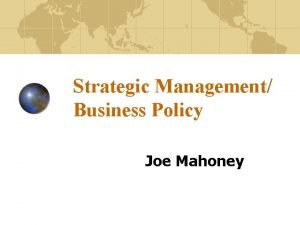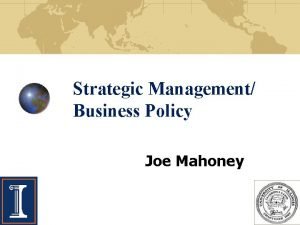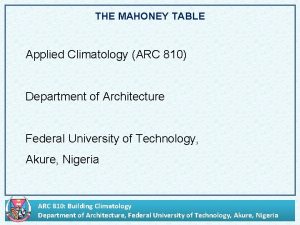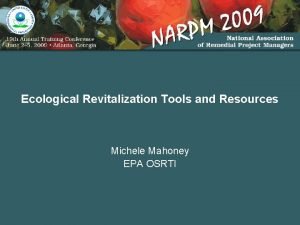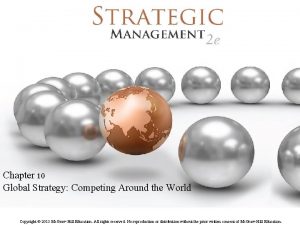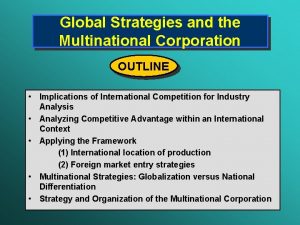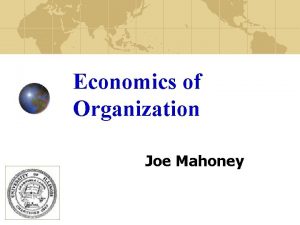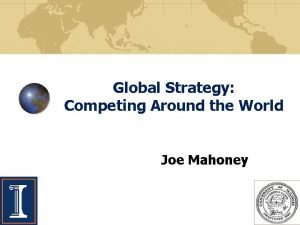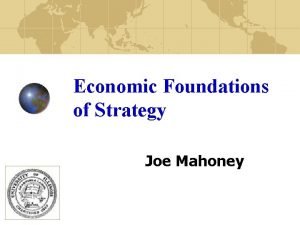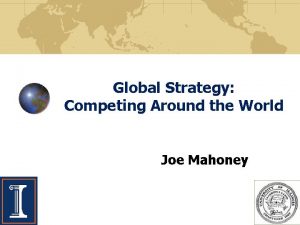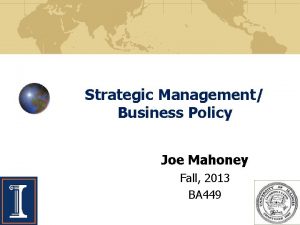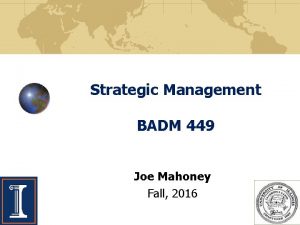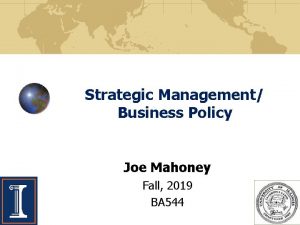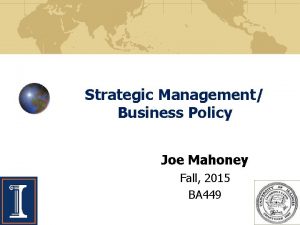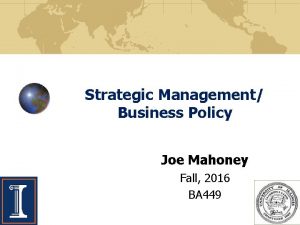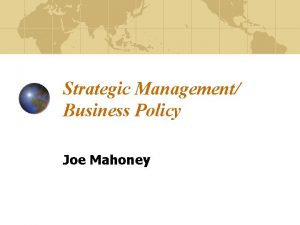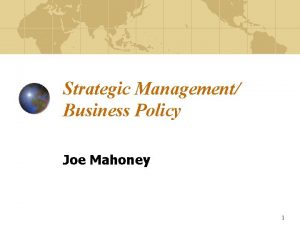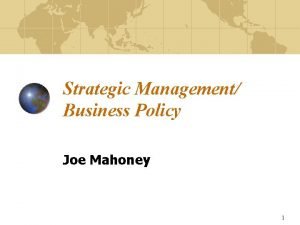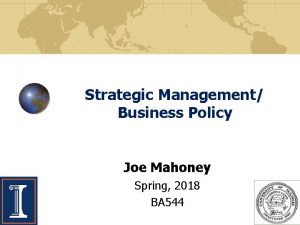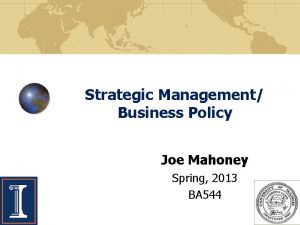Chapter 1 What is Strategy Joe Mahoney Fall




















- Slides: 20

Chapter 1: What is Strategy? Joe Mahoney Fall, 2019 BA 544

Definitions of Strategy • "The term 'strategy' is intended to focus on the interdependence of the adversaries’ decisions and on their expectations about each other’s behavior. ” (Thomas Schelling, The Strategy of Conflict) • “Strategy can be defined as the determination of the basic long- term goals and objectives of an enterprise, and the adoption of courses of action and the allocation of resources necessary for carrying out those goals. ” (Alfred D. Chandler, Strategy and Structure) • Strategy is: “The pattern or plan that integrates an organization’s major goals, policies, and action sequences into a cohesive whole. A well formulated strategy helps to marshal and allocate an organization’s resources into a unique and viable posture based on its relative internal competencies and shortcomings, anticipated changes in the environment, and contingent moves by intelligent opponents. ” (James Brian Quinn, Logical Incrementalism) 1– 2

What is Strategy? Definition: Strategy is the quest to create, capture, and sustain competitive advantage. • It is the managers’ theories/maps about how to sustain advantage. • It is about deciding what to do, and what not to do (i. e. , economic tradeoffs are considered; opportunity cost). • It has alternatives, consequences, and choices involving significant resources, typically made under some level of uncertainty. • It requires long-term commitments that are not easily reversible. • It is about being different from your rivals. It combines a set of activities to stake out a unique positioning.

Unique Positioning • The key to successful strategy: combine activities for a unique position in an industry. • Competitive advantage has to come from: – performing different activities, or – performing the same activities differently than rivals • Example: Wal-mart’s strategic activities strengthen its position as cost leader (p. 9) – – Big stores in rural locations; regional distribution centers, IT systems High purchasing power Low corporate overhead Low base wages Copyright © 2017 by Mc. Graw-Hill Education. This is proprietary material solely for authorized instructor use. Not authorized for sale or distribution in any manner. This document may not be copied, scanned, duplicated, forwarded, distributed, or posted on a website, in whole or part.

Strategic Management • Strategic Management: an integrative management field that combines analysis, formulation, and implementation in the quest for sustainable competitive advantage (SCA). Ø Mastery of strategic management enables us to more fully view the firm in its entirety; and Ø It also enables us to think like a general manager to help position our firm for SCA, which can be viewed as positive economic profit (taking into account the opportunity cost of capital), and which can be operationalized as positive NPV.

Strategy as a Theory of How to Compete to Create Superior Value, While Containing the Cost to Create It The greater the difference between the value creation and cost, the greater the firm’s economic contribution and the more likely it will achieve sustainable competitive advantage (SCA). Wal-mart's Sam Walton's assumptions about low costs, low prices, and high volume to drive profitability v Apple’s Steve Jobs wanted to “put a ding in the universe” v Facebook’s Mark Zukerberg wanted to “make the world open and connected” v Google’s Larry Page and Sergio Brin wanted to make information accessible (p. 8) v

Key Drivers of Value Creation and Sustainable Competitive Advantage (SCA) • Generating economic value can be accomplished through: Ø REVENUE drivers Ø COST drivers Ø RISK drivers

Value and Cost Drivers Figure 2. 5

Industry, Firm, and Other Effects Explaining Superior Firm Performance Exhibit 1. 1 Copyright © 2017 by Mc. Graw-Hill Education. This is proprietary material solely for authorized instructor use. Not authorized for sale or distribution in any manner. This document may not be copied, scanned, duplicated, forwarded, distributed, or posted on a website, in whole or part.

10

Levels of Strategy • Corporate Level: Typically involves decision-making by the top management team that includes the CEO, senior executives, the board of directors, and the corporate staff. Decisions include vertical integration, diversification, strategic alliances, acquisitions, new ventures, restructuring, and divestments. • Business Level: Includes the strategic choice of generic strategy (cost leadership, differentiation, focus) and the benefits and costs of first-mover advantages. Often an enterprise participating in multiple businesses will have different business strategies. • Functional Level: Typically directed at improving the effectiveness of functional operations within a company, such as manufacturing, materials management, human resources, marketing, R&D, and operations management. 1– 11

Strategy Across the Levels • Where to Compete? Ø Should GE move more aggressively into the health care industry? • How to Compete? Ø Should GE jet engines have better fuel efficiency than Rolls Royce? • How to Implement? Ø Should GE human resources recruit more science graduates? • CORPORATE STRATEGY • BUSINESS STRATEGY • FUNCTIONAL STRATEGY 1– 12

The Manager’s Role in Balancing Expectations • Business Roundtable: Ø “Balancing the shareholder’s expectations of maximum return against other priorities is one of the fundamental problems confronting corporate management. ” • Understanding corporate strategy means understanding the competing value claims of multiple stakeholders. • Stakeholders are the individuals and groups who can affect, and are affected by, the strategic outcomes achieved and who have enforceable claims on a firm’s performance.

Internal and External Stakeholders in an Exchange Relationship with the Firm 1– 14

Stakeholder Management • Target Corporation has numerous awards that reflect its strong relationship with its stakeholders. It has been named on lists such as best places to work, most admired companies, most ethical companies, best in class for corporate governance, and grassroots innovation. Since its founding, Target has given 5% of its profits to education, the arts, and social services in the communities in which it operates, and reached the milestone of contributing $4 million per week in 2012 (p. 15). • To demonstrate its commitment to minorities and women, Target launched a program to bring minority- and women-owned businesses into its supply chain. Volunteerism and corporate giving strengthen the relationship Target has with its employees, consumers, local communities, and suppliers. These actions, along with many others, can help Target gain competitive advantage as a retailer as long as the benefits Target accrues from its stakeholder strategy exceed the costs of such programs. Copyright © 2017 by Mc. Graw-Hill Education. This is proprietary material solely for authorized instructor use. Not authorized for sale or distribution in any manner. This document may not be copied, scanned, duplicated, forwarded, distributed, or posted on a website, in whole or part.

16 Stakeholder Impact Analysis Exhibit 1. 3 Copyright © 2017 by Mc. Graw-Hill Education. This is proprietary material solely for authorized instructor use. Not authorized for sale or distribution in any manner. This document may not be copied, scanned, duplicated, forwarded, distributed, or posted on a website, in whole or part.

Identify Societal Responsibilities The Pyramid of Corporate Social Responsibility SOURCE: Adapted from A. B. Carroll (1991), “The pyramid of corporate social responsibility: Toward the moral management of organizational stakeholders, ” Business Horizons, July-August: 42. Copyright © 2017 by Mc. Graw-Hill Education. This is proprietary material solely for authorized instructor use. Not authorized for sale or distribution in any manner. This document may not be copied, scanned, duplicated, forwarded, distributed, or posted on a website, in whole or part. Exhibit 1. 4

Strategy Highlight BP Grossly Negligent in Gulf of Mexico Disaster • On April 20, 2010, an explosion occurred. – At a drilling rig off the Louisiana coastline – Killed 11 workers • The oil spill continued for over three months. • It released an estimated 5 million barrels of crude oil into the Gulf of Mexico (The largest environmental disaster in U. S. history) • The cleanup cost was $14 billion • Tony Hayward, BP’s CEO at the time, was fired. • Experts said BP’s problems were systemic: – Management repeatedly failed to put a safety culture in place. Copyright © 2017 by Mc. Graw-Hill Education. This is proprietary material solely for authorized instructor use. Not authorized for sale or distribution in any manner. This document may not be copied, scanned, duplicated, forwarded, distributed, or posted on a website, in whole or part. 18

Strategy Highlight BP Grossly Negligent in Gulf of Mexico Disaster • BP faced thousands of claims by many small business owners. – Mainly in the tourism and seafood industries • Collectively, small business owners became powerful BP stakeholders and BP paid over $25 billion to settle their claims. – Total cost for this incident: $60 billion • The Environmental Protection Agency (EPA) banned BP from any new contracts with the U. S. government. – This ban puts BP at a major competitive disadvantage. Copyright © 2017 by Mc. Graw-Hill Education. This is proprietary material solely for authorized instructor use. Not authorized for sale or distribution in any manner. This document may not be copied, scanned, duplicated, forwarded, distributed, or posted on a website, in whole or part.

Strategy Highlight BP Grossly Negligent in Gulf of Mexico Disaster • What advice would you give to BP’s managers to help them continue to rebuild stakeholder relationships in the Gulf region and beyond? • How can BP repair its damaged reputation? Copyright © 2017 by Mc. Graw-Hill Education. This is proprietary material solely for authorized instructor use. Not authorized for sale or distribution in any manner. This document may not be copied, scanned, duplicated, forwarded, distributed, or posted on a website, in whole or part. 20
 Joe mahoney electric
Joe mahoney electric Joe mahoney uiuc
Joe mahoney uiuc Mahoney table
Mahoney table Katherine mahoney ospi
Katherine mahoney ospi Michele mahoney
Michele mahoney Professor craig mahoney
Professor craig mahoney Mary mahoney scholarship
Mary mahoney scholarship Business strategy vs corporate strategy
Business strategy vs corporate strategy Home replication strategy example
Home replication strategy example Chase strategy examples
Chase strategy examples Global operations strategy options
Global operations strategy options Aligning hr strategy with business strategy
Aligning hr strategy with business strategy Liability of foreignness
Liability of foreignness Strategy executing process
Strategy executing process Strategy formulation and implementation
Strategy formulation and implementation Listening strategies activities
Listening strategies activities Directional strategy in strategic management
Directional strategy in strategic management International or multinational
International or multinational Reverend smith things fall apart
Reverend smith things fall apart Things fall apart chapters 20-25
Things fall apart chapters 20-25 Week of peace things fall apart
Week of peace things fall apart
